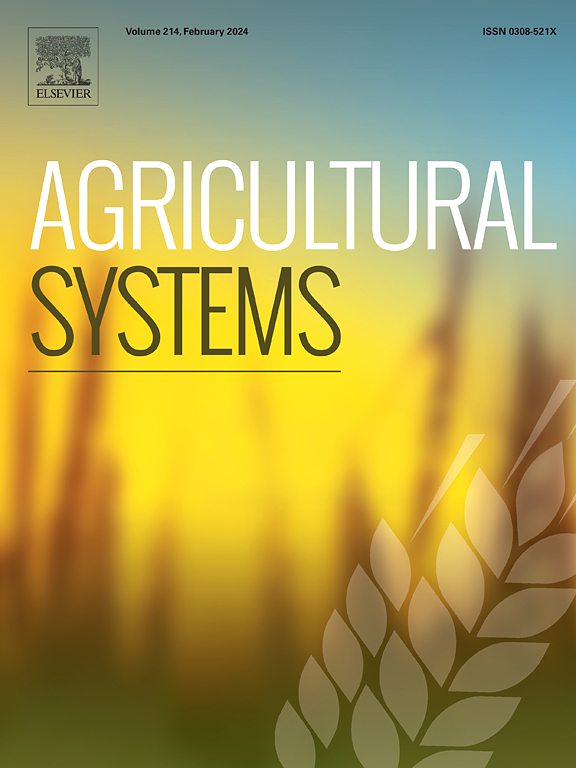1981年以来,品种变化抵消了气候变暖对中国大豆物候的影响
IF 6.1
1区 农林科学
Q1 AGRICULTURE, MULTIDISCIPLINARY
引用次数: 0
摘要
作物物候是反映气候变化对农业系统影响的重要生态指标。由于大豆是中国最重要的经济作物之一,研究大豆物候的动态和驱动因素对于制定适应方案至关重要。本文章由计算机程序翻译,如有差异,请以英文原文为准。

Cultivar shifts have offset climate warming impacts on soybean phenology in China since 1981
CONTEXT
Crop phenology is a critical ecological indicator reflecting the impact of climate change on agricultural systems. As soybean is one of the most important economic crops in China, investigating the dynamics and drivers of soybean phenology is essential for developing adaptation options.
OBJECTIVE
The objectives of this study are to investigate the trends in key soybean phenological stages and growth periods across China from 1981 to 2020, understand their responses to various climatic factors, and disentangle the contributions of different climatic and anthropogenic factors between the cooler (1981–2000) and the warmer (2001−2020) periods.
METHODS
The latest and comprehensive observations, including phenological and climatic information, at 71 agro-meteorological stations across China from 1981 to 2020 were used. By using the Decision Support System for Agrotechnology Transfer–CROPGRO (DSSAT-CROPGRO) crop phenology mechanism model and statistical methods, we first analyzed the spatiotemporal dynamics of soybean phenology, and then disentangled the contributions of different climatic and anthropogenic factors to changes in the growth period through factorial simulation experiments.
RESULTS AND CONCLUSIONS
The overall trends in all the soybean phenological dates were delayed, with the growth period (GP) slightly shortened. On average, climate change shortened the GP by 1.7 days/decade from 1981 to 2020, whereas cultivar shifts extended the GP by 3.1 days/decade, offsetting the negative impact of climate change. The impacts of climate on soybean phenology significantly weakened from 2001 to 2020 relative to 1981–2000. The shortening of the GP by climatic drivers decreased from 5.9 to 1.3 days/decade, whereas the GP elongation by cultivar shifts decreased from 6.7 to 3.3 days/decade.
SIGNIFICANCE
Our findings reveal the trends in soybean phenology and its drivers in China over the past 40 years, and deepen the understanding of the impacts of climate change and the adaptation of soybean production, providing a solid foundation for the development of climate change adaptation options.
求助全文
通过发布文献求助,成功后即可免费获取论文全文。
去求助
来源期刊

Agricultural Systems
农林科学-农业综合
CiteScore
13.30
自引率
7.60%
发文量
174
审稿时长
30 days
期刊介绍:
Agricultural Systems is an international journal that deals with interactions - among the components of agricultural systems, among hierarchical levels of agricultural systems, between agricultural and other land use systems, and between agricultural systems and their natural, social and economic environments.
The scope includes the development and application of systems analysis methodologies in the following areas:
Systems approaches in the sustainable intensification of agriculture; pathways for sustainable intensification; crop-livestock integration; farm-level resource allocation; quantification of benefits and trade-offs at farm to landscape levels; integrative, participatory and dynamic modelling approaches for qualitative and quantitative assessments of agricultural systems and decision making;
The interactions between agricultural and non-agricultural landscapes; the multiple services of agricultural systems; food security and the environment;
Global change and adaptation science; transformational adaptations as driven by changes in climate, policy, values and attitudes influencing the design of farming systems;
Development and application of farming systems design tools and methods for impact, scenario and case study analysis; managing the complexities of dynamic agricultural systems; innovation systems and multi stakeholder arrangements that support or promote change and (or) inform policy decisions.
 求助内容:
求助内容: 应助结果提醒方式:
应助结果提醒方式:


